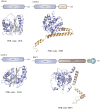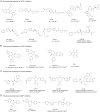Potential roles of UCH family deubiquitinases in tumorigenesis and chemical inhibitors developed against them
- PMID: 39005671
- PMCID: PMC11236784
- DOI: 10.62347/OEGE2648
Potential roles of UCH family deubiquitinases in tumorigenesis and chemical inhibitors developed against them
Abstract
Deubiquitinating enzymes (DUBs) are a large group of proteases that reverse ubiquitination process and maintain protein homeostasis. The DUBs have been classified into seven subfamilies according to their primary sequence and structural similarity. As a small subfamily of DUBs, the ubiquitin C-terminal hydrolases (UCHs) subfamily only contains four members including UCHL1, UCHL3, UCHL5, and BRCA1-associated protein-1 (BAP1). Despite sharing the deubiquitinase activity with a similar catalysis mechanism, the UCHs exhibit distinctive biological functions which are mainly determined by their specific subcellular localization and partner substrates. Besides, growing evidence indicates that the UCH enzymes are involved in human malignancies. In this review, the structural information and biological functions of the UCHs are briefly described. Meanwhile, the roles of these enzymes in tumorigenesis and the discovered inhibitors against them are also summarized to give an insight into the cancer therapy with the potential alternative strategy.
Keywords: Deubiquitinase; UCH family; cancer; inhibitors.
AJCR Copyright © 2024.
Conflict of interest statement
None.
Figures









Similar articles
-
Ubiquitin carboxyl-terminal hydrolases: involvement in cancer progression and clinical implications.Cancer Metastasis Rev. 2017 Dec;36(4):669-682. doi: 10.1007/s10555-017-9702-0. Cancer Metastasis Rev. 2017. PMID: 29080080 Review.
-
Ubiquitin Carboxyl-Terminal Hydrolases (UCHs): Potential Mediators for Cancer and Neurodegeneration.Int J Mol Sci. 2020 May 30;21(11):3910. doi: 10.3390/ijms21113910. Int J Mol Sci. 2020. PMID: 32486284 Free PMC article.
-
The potential role of ubiquitin c-terminal hydrolases in oncogenesis.Biochim Biophys Acta. 2010 Aug;1806(1):1-6. doi: 10.1016/j.bbcan.2010.03.001. Epub 2010 Mar 17. Biochim Biophys Acta. 2010. PMID: 20302916 Review.
-
Friend or Foe: UCHL3 Mediated Carcinogenesis and Current Approaches in Small Molecule Inhibitors' Development.Curr Med Chem. 2021;28(42):8782-8799. doi: 10.2174/0929867328666210708085544. Curr Med Chem. 2021. PMID: 34238144 Review.
-
Essential role of maternal UCHL1 and UCHL3 in fertilization and preimplantation embryo development.J Cell Physiol. 2012 Apr;227(4):1592-603. doi: 10.1002/jcp.22876. J Cell Physiol. 2012. PMID: 21678411 Free PMC article.
Cited by
-
UCHL3: a crucial deubiquitinase in DNA damage repair and tumor progression.Cancer Cell Int. 2025 Jul 21;25(1):276. doi: 10.1186/s12935-025-03884-x. Cancer Cell Int. 2025. PMID: 40691601 Free PMC article. Review.
-
Deubiquitinases as novel therapeutic targets for diseases.MedComm (2020). 2024 Dec 13;5(12):e70036. doi: 10.1002/mco2.70036. eCollection 2024 Dec. MedComm (2020). 2024. PMID: 39678489 Free PMC article. Review.
-
Proteasomes and Ubiquitin C-Terminal Hydrolase L1 as Biomarkers of Tissue Damage and Inflammatory Response to Different Types of Injury-A Short Review.Life (Basel). 2025 Mar 6;15(3):413. doi: 10.3390/life15030413. Life (Basel). 2025. PMID: 40141757 Free PMC article. Review.
-
Ubiquitin-Proteasome System in Periodontitis: Mechanisms and Clinical Implications.Cell Prolif. 2025 Mar;58(3):e13781. doi: 10.1111/cpr.13781. Epub 2024 Dec 3. Cell Prolif. 2025. PMID: 39626954 Free PMC article. Review.
-
Comprehensive pan-cancer analysis indicates UCHL5 as a novel cancer biomarker and promotes cervical cancer progression through the Wnt signaling pathway.Biol Direct. 2024 Dec 19;19(1):139. doi: 10.1186/s13062-024-00588-6. Biol Direct. 2024. PMID: 39702250 Free PMC article.
References
-
- Farley AR, Link AJ. Identification and quantification of protein posttranslational modifications. Methods Enzymol. 2009;463:725–763. - PubMed
-
- Montagut AM, Armengol M, de Pablo GG, Estrada-Tejedor R, Borrell JI, Roue G. Recent advances in the pharmacological targeting of ubiquitin-regulating enzymes in cancer. Semin Cell Dev Biol. 2022;132:213–229. - PubMed
Publication types
LinkOut - more resources
Full Text Sources
Research Materials
Miscellaneous
